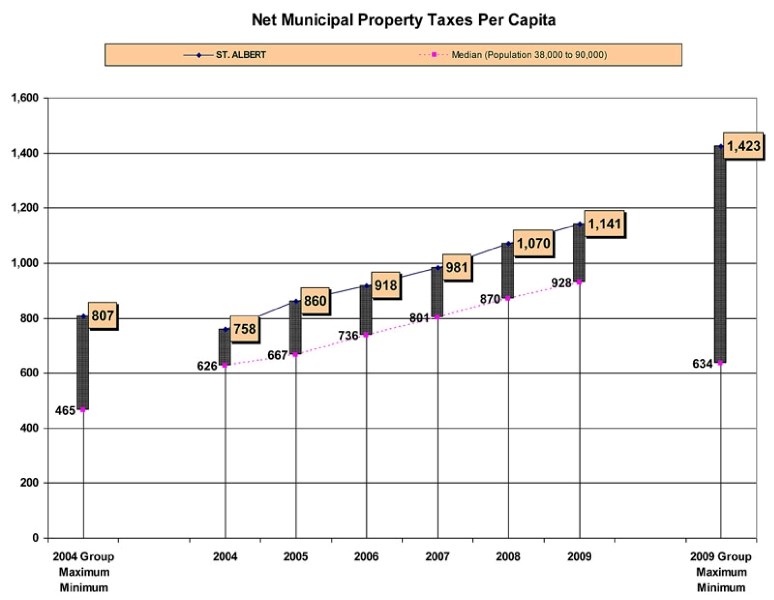A recent provincial report reinforces St. Albert’s status as a high-tax locale that’s starved for non-residential development.
St. Albert’s residential and non-residential ratepayers paid $1,141 in per capita municipal property taxes in 2009. This was 23 per cent more than the group median for mid-sized municipalities, at $928. Grande Prairie was the highest in the group at $1,423.
The report, which the city received in late 2010, is an internal document prepared annually for Alberta municipalities by the financial advisory services branch of Alberta Municipal Affairs. The figures are for the year ended Dec. 31, 2009.
The financial indicator graphs that comprise the 26-page document compare St. Albert with six other medium-sized Alberta cities: Airdrie, Grande Prairie, Lethbridge, Medicine Hat and Red Deer.
In terms of per capita property taxes, St. Albert has consistently been about $200 higher than the group median for several years.
“It certainly tells me that there’s room for improvement,” said Coun. Cam MacKay. “It’s not like we’re doing really horrible but we definitely have room for improvement.”
Other charts show that St. Albert’s overall per capita spending was $2,074, or 17 per cent below the median level of $2,497.
St. Albert spent 39 per cent less than the group per capita median for materials, goods and supplies, 23 per cent less on contracted and general services and 8.7 per cent less on salaries, wages and benefits. The city was also 31 per cent below the median in the amount of per capita sales and user fees charged.
“Although our taxes are high, in terms of our cost per capita, we’re well-managed and operating efficiently with the resources that we’ve got,” said city manager Bill Holtby.
Holtby and MacKay both noted that some of St. Albert’s spending doesn’t compare well to other municipalities. For example, the city doesn’t hire its own transit drivers or directly hire employees for arm’s length groups like the Arts & Heritage Foundation.
“It actually makes us look a lot better than we are in some areas,” MacKay said of the report. “You can get a lot of information from that but I’m always careful as to what it means.”
The overall picture painted is that St. Albert residents pay more in property taxes but the city spends less than others, Holtby said, which points to the issue that municipal leaders have been grappling with for years.
“The sole reason would be the lack of non-residential taxation,” he said.
The proportion of total tax assessment coming from the non-residential sector jumped from nine per cent to 11 per cent between 2009 and 2010, the report shows. The split had been 89/11 for several years before shifting to 91/9 in 2009. City officials have long held a split of 80/20 as the target necessary for reducing the burden on residential taxpayers.
The city gets the report every year and uses the information as a benchmark for future budget planning, Holtby said.




